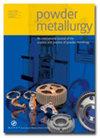火花等离子体烧结的小型试验装置——实验和数值研究
IF 1.8
4区 材料科学
Q2 METALLURGY & METALLURGICAL ENGINEERING
引用次数: 0
摘要
本文章由计算机程序翻译,如有差异,请以英文原文为准。
Miniaturised test-setup for Spark Plasma Sintering – experimental and numerical investigations
ABSTRACT Spark Plasma Sintering (SPS) is an innovative sintering technique, whereby many of the beneficial effects of this process on sintering are still elusive. To allow for the detailed investigations of the SPS process, a custom experimental set-up and a corresponding finite element (FE) model was developed. The miniaturised setup allows for very high current intensities, custom pulse patterns, a wide pressure range and dilatometric measurements. The FE model was employed to calculate the temperature field in the set-up and the sintering specimen itself. A very good correlation of the temperature, current and voltage over the entire process was observed. Our investigations show that the contact conductivities have a significant impact on the process temperature. Also, the imperfect contacts at the interfaces between the graphite foil and the real specimen may lead to a significant variance of the currents necessary to obtain the desired sintering temperature.
求助全文
通过发布文献求助,成功后即可免费获取论文全文。
去求助
来源期刊

Powder Metallurgy
工程技术-冶金工程
CiteScore
2.90
自引率
7.10%
发文量
30
审稿时长
3 months
期刊介绍:
Powder Metallurgy is an international journal publishing peer-reviewed original research on the science and practice of powder metallurgy and particulate technology. Coverage includes metallic particulate materials, PM tool materials, hard materials, composites, and novel powder based materials.
 求助内容:
求助内容: 应助结果提醒方式:
应助结果提醒方式:


